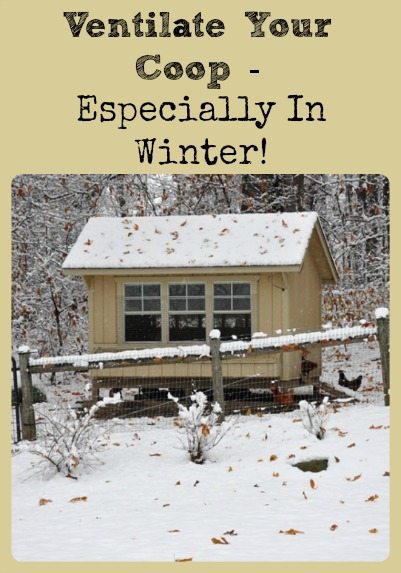
An extremely important element of successful chicken keeping is assuring that there is adequate ventilation in the chicken coop. Failing to plan for or provide sufficient airflow is a frequent mistake that poultry keepers make. And, it can quickly lead to sick birds.
Chickens generate a lot of moisture, ammonia, and heat – so it’s absolutely critical to ventilate well to remove the excess from the coop. The more time your chickens spend indoors, the more important it is to supply good ventilation.
Beginning chicken keepers often believe that coops should be airtight and insulated, but nothing could be further from the truth. Providing plenty of ventilation keeps chickens healthy by reducing harmful ammonia fumes, removing excess moisture, supplying oxygen-rich air, reducing airborne disease organisms, removing irritating dust, and reducing heat in the coop.
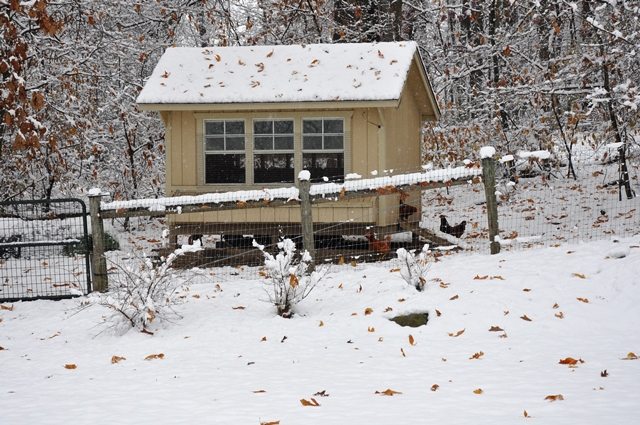
Chicken Coop Winter Ventilation
Why Coops Need Ventilation
1. ELIMINATE HARMFUL AMMONIA FUMES
A great deal of ammonia is released into the chicken coop from the chicken’s droppings. Ammonia fumes can cause your flock everything from irritated eyes and sinuses to respiratory distress, overall poor health or even death in extreme cases. Placing ventilation up high in your coop, well above the level of your roosts, ensures that the ammonia fumes created by the chicken manure in your coop will escape and not be trapped inside.
An easy way to check whether your coop ventilation is adequately removing ammonia fumes is to check for ammonia smell, if you can detect ammonia near the coop floor (at approximately the same height as the chickens), then the coop airflow needs to be increased.
2. REMOVE MOISTURE FROM THE COOP
Chickens don’t sweat, but they do generate a tremendous amount of water vapor. They generate it both by breathing and from their droppings, and all that water vapor causes chicken coops to be humid. High humidity makes chickens more susceptible to respiratory illness and frostbite.
Good ventilation removes this dampness and humidity from the coop, reduces respiratory problems, and chickens can withstand surprisingly cold temperatures if the coop air is dry. Chickens are naturally cold hardy but their legs, combs, and wattles are not protected with feathers and are susceptible to frostbite.
Frostbite occurs in the presence of sub-freezing temperatures and moisture. This moisture settles on the chicken’s vulnerable combs, wattles, and toes and is the perfect condition for frostbite to occur. Keeping the coop dry and well ventilated will solve the problem of frostbite.
3. PROVIDE OXYGEN-RICH FRESH AIR
Chickens deplete oxygen in the coop quickly because they have such a high respiratory rate, and also produce large quantities of carbon dioxide. In order to get the oxygen they need to survive, the carbon dioxide-laden air must frequently be replaced by fresh oxygen-rich air.
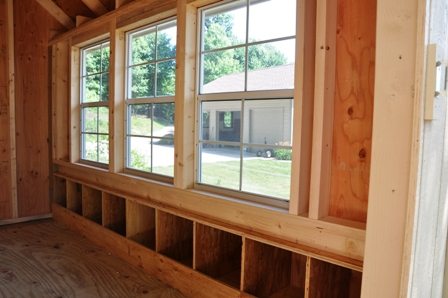
Coop Interior Front Ventilation
4. REDUCE AIRBORNE DISEASE ORGANISMS
Because of their high respiratory rate, chickens are also quite susceptible to airborne diseases. Although they can’t be seen, airborne disease organisms buildup quickly in stagnant air inside a chicken coop and can cause an entire flock to become ill. Again, it’s critical that airborne disease organisms be minimized by moving them out of the coop with fresh air.
5. REMOVE RESPIRATORY IRRITATING DUST
Chickens are well known for producing lots of dust, and all that dust in the confined space of a coop fills the air with dust particles. Because of their high respiratory rate and sensitive respiratory systems, all those dust particles need to be regularly removed from the coop to keep the flock healthy.
6. REDUCE HEAT RELEASED DURING BREATHING
Since chickens don’t sweat, they release their heat by breathing and are constantly adding heat to the coop. Chickens are better equipped to handle cold weather than hot weather and do best at temperatures below 75°F. They really begin to suffer at temperatures above 90°F and can die, so ventilation is needed to keep the coop cool, particularly during warm summer weather.
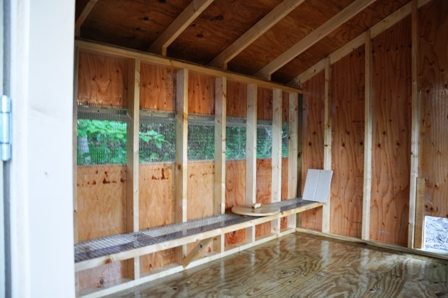
Coop Backwall Ventilations (Above Roosts)
When To Keep Coops Ventilated
The amount and location of ventilation needed in a chicken coop vary according to the season and the weather conditions during each season. But, chickens produce water vapor, ammonia, carbon dioxide, and heat continuously; while dust and airborne disease organisms are always accumulating, so chicken coops need to be ventilated at all times. Some think that chicken coops should be closed up during cold weather to keep the birds warm, but that’s not true. They need ventilation all year long.
But ventilation is different than a draft. A draft is air blowing directly onto the chickens while they roost and should be avoided. Ventilation is airflow rising naturally from a lower position to an exhaust opening or ridge. Ventilation will naturally carry away the heat and harmful substances that can lead to problems in your chickens.
In cold weather, make sure that the ventilation isn’t causing drafts. Cold weather ventilation should be high up and protected from rain or snow by roof overhangs. You don’t want a cold draft wafting across your chicken roost(s) at night. In warm weather, vents that provide a breeze are good so openings lower in the coop are desirable.
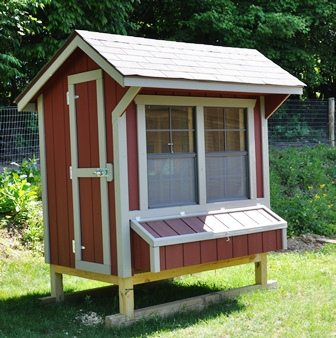
Well Ventilated Small Coop
How Much To Ventilate
The general rule of thumb is to have 1/5th of your coop walls be windows or vents. The lower windows can be left open in the summer and then closed in the colder months, leaving only vents up high open. If the climate is very wet or the coop is crowded, then more than the recommended amount of ventilation will be needed.
A fan may be necessary, particularly in warmer climates, to provide an adequate flow of fresh air. A fan that can supply 5 cubic feet per minute, per chicken in the coop will usually provide adequate ventilation.
There are many manufactured chicken coops available for purchase, but that doesn’t mean they have sufficient ventilation. It may be necessary to add additional openings for your conditions.
When adding ventilation openings, be sure to cover them adequately with hardware cloth (a welded wire product). This will keep predators from gaining access through any openings in the coop. It comes in quarter-inch and half-inch varieties that are adequate for keeping out rodents and larger predators.
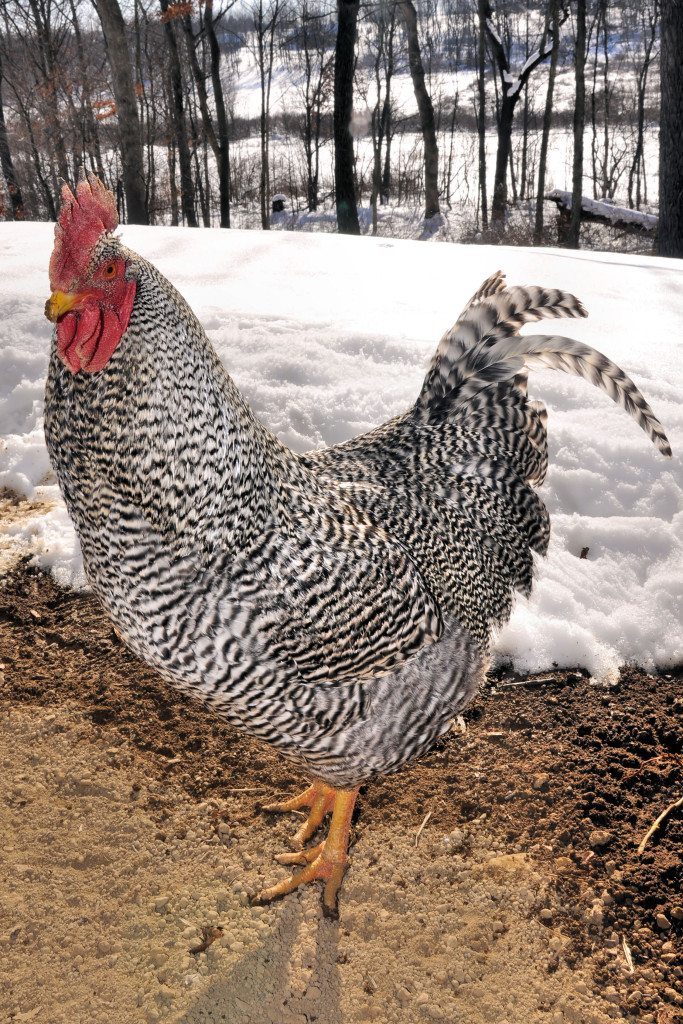
Will – Barred Rock Rooster In Snow
Obviously, the amount and location of ventilation needed changes as weather conditions change. So, it’s important to have many ventilation options that can be opened or closed as necessary. Consider your coop ventilation requirements carefully, and plan for more, not less. And, don’t shut off all the ventilation in winter – chickens need it then too! Check out other important chicken coop design features in 10 Important Chicken Coop Design Features.
Marty says
We’re new to chickens, so just starting out. We live in North-Central Ohio – not ARCTIC cold or Texas hot, but we have a wide range of temps throughout the year (well below 0- low 90’s). We’re looking at building the coop inside an existing pole shed, using 2 of the walls of the shed as 2 of the walls of the coop- meaning we’d just have to build the floor, 2 walls and a roof. The shed is completely open on one side (we’d have plenty of ventilation built on that open side) , but dh is loathe to cut holes in in the barn siding to allow a cross breeze. If I ventilate only on the 2 walls we build (they’ll be perpendicular to each other) would that be enough? Should I cut holes in the roof? (The roof of the shed will still be there to protect from weather). Am I overt thinking this? Thanks!
Abeer Bai'a says
Thanks for the information…very helpful…i live in Jordan in the middle east where winter is real cold and windy …have a backyard coop with one high window is it enough …i am thinking to cover the west side of the run with heavy plastic to break the cold wind
mary says
I live in North Iowa – temps dip to 30 below zero. My windows will remain closed, thank you.
Brenda Hipkins says
Very informative. Thanks for posting this. We intend to add a small chicken flock in the spring and I will save this post to use in the late fall.
karen says
Thanks for this great information. I only have three girls and they don’t spend a lot of time inside except when it is real windy and below freezing. They have a lot of space in a 16 x 10 space but I might want to open those upper high vents when they are in all day when it’s so cold.
Dawn Hatchard says
Oh I wish I could I could keep the windows and/or doors open at -50 degrees!
Plenty of ventilation is allowed until around 0 degrees in the dry, not too windy Alaskan interior. -20 is where things start getting tricky and -30 a small heat source is needed and a light on a timer because of all the darkness.
Granted, most of the people in the US don’t have to deal with such extremes.
The chick says
In Wyoming it certainly drops 30 below AND white out snow blowing is a gentle breeze. My chickens had chicken wire at the top of the coop & the door was made up of chicken wire & wood frame. Snow blew in one side a few times. They actually didn’t seem fazed! I bedded everything deep & fluffed the bedding a few times. Didn’t loose one bird, & they all seemed fine. I won’t be using a lamp, & won’t be leaving the coop window on the new shed (old one was just too small after we got over 30 birds this summer) when the snow blows. However, the window will be open when it’s decent out. I am making one adjustment…I won’t be walking buckets out to fill water several times per day when it freezes so quickly. I got a heated waterer!!
Lesa says
Congratulations on that heated waterer, it really helps out in winter!
Misty says
So, I have a tiny coop, approximately 3 for by 3 ft and about 4.5 foot tall at the top of the a-framed roof(house shaped) the doorway is centered on the bottom (about 18t X12w inches) the only other opening is across the back about half way up a hinged trap door to gather eggs from the two nesting boxes. The roost is a few inches higher than the nesting boxes, any suggestions for ventilating? It has a small run attached to the front that is 4 ft tall, 3 foot wide and 6 foot long. with clear vinyl on the northside to block the Oklahoma winter wind.
Colleen says
We were just given a 10’x10′ wooden shed with a small window and a sliding glass door. The previous owner kept poultry in there. We only have 8 chickens. There are no vents and it has been in around 20•F The she’d is along the west side of a tree line with flat crop lands south and north of us so it gets windy! I have been leaving the window and door open 1″ while they are in it. They haven’t wanted to come out since it snowed (normally free range). How much should I open them? No frost on the inside windows. I use hardwood shavings. The heated water and food are inside. Thanks!
Jess says
Do you close the windows at night though? What about on really windy days?
Lesa says
Hi Jess, no we do not close the windows at night, we are trying to keep the humid air moving out, because they really do much better in dry, cold air. I guess on a really windy day when it’s torrentially raining, we consider closing the windows.
The Hen Song says
Great article! Well written and easy to understand. Living in Alaska, we get these questions all the time. Granted, at first glance it does seem counter intuitive, but you explain it very well. Thank you!
Carrie Nowlin says
I have this coop: http://www.tractorsupply.com/en/store/precision-pet-products-chicken-coop-retractable-wheel-kit. I have plastic wrapped around the open areas with small spaces at the top of the hardware cloth. I am not sure how to “vent” the little house area…should I drill some small holes at the very top underneath the roof overhang? My two girls sit on a roost in there, so it would be up above their heads. The front faces north and the tall side (hardware cloth) faces west. Both are protected. I keep the tray under their roost clean every day…just worry they still aren’t getting enough vent, but don’t want to cause a draft. Please advise! Thanks! I have not been able to get a straight answer from anyone on EXACTLY what I should do with this small coop! Help!
Lesa says
Hi Carrie, so those are not real windows in the little house area? If not, I think it would be a very good idea to drill holes to vent. It’s good to keep the air moving above their heads in winter, and we our chickens just go out into the pasture – no plastic wrapping needed.
Lisa @ Fresh Eggs Daily says
Great post. Your coop is really cute too!
Lesa says
Hi Lisa, I’d never considered my coop to be “cute” – I’m seeing it in a whole new way. Thanks!
Lisa @ Fresh Eggs Daily says
Not cutesy…just cute. Or maybe its just my snow envy talking!
Jen says
That coop is seriously adorable! Great info – thanks!
Lesa says
Thanks Jen!
Debbie says
I don’t understand how to ventalate and not have a draft. I have 3 windows in my coop. Two are high and one is low. Should I leave one open, and which one?
Lesa says
Hi Debbie, if you are in cold weather, then you don’t want the ventilation to be drafting cold air across the chickens as they roost, eat, etc. but you do want it moving the air out of the coop. I’m not familiar with your coop, but I would probably leave the both of the ones that are high open during cold weather. In warm weather, I’d probably open them all (provided they are adequately covered so that predators can’t get in). Again, I don’t know what your coop looks like, so you’ll need to decide if that makes sense.
Debbie says
Thanks Lesa! Yes I am in cold weather in Ohio. I was told to cover my windows with plexiglass in the winter. Otherwise they are open all the time. (covered with a screen). I open the door to their pen during the day but they will not come out. Sometimes they are in their boxes all day. I only have three chickens (Golden Buff) so I am always worried they are going to freeze. Thanks again for your help.
Lesa says
We have kept Golden Buffs and Buckeyes for quite a few years now, and no one has frozen despite open windows 🙂